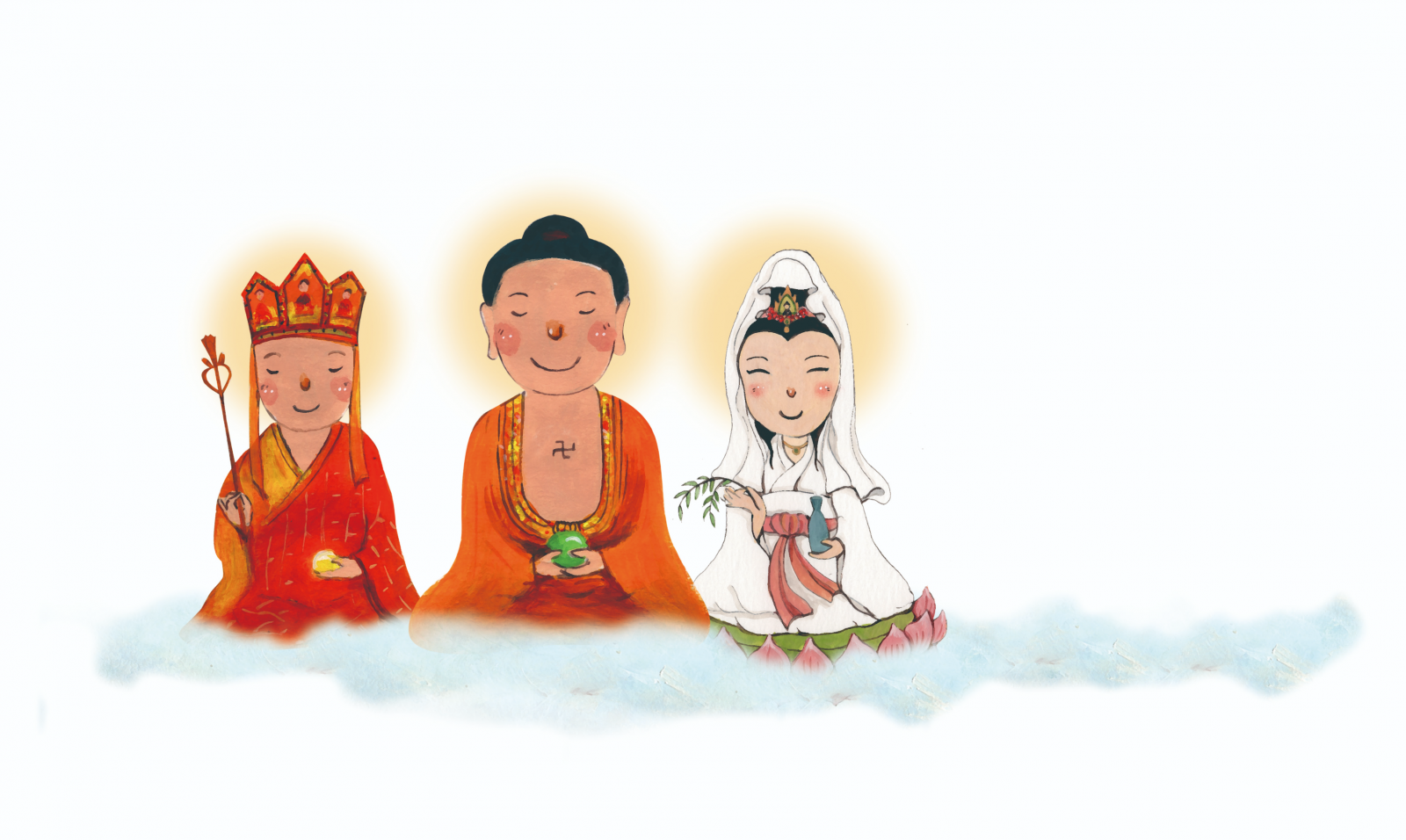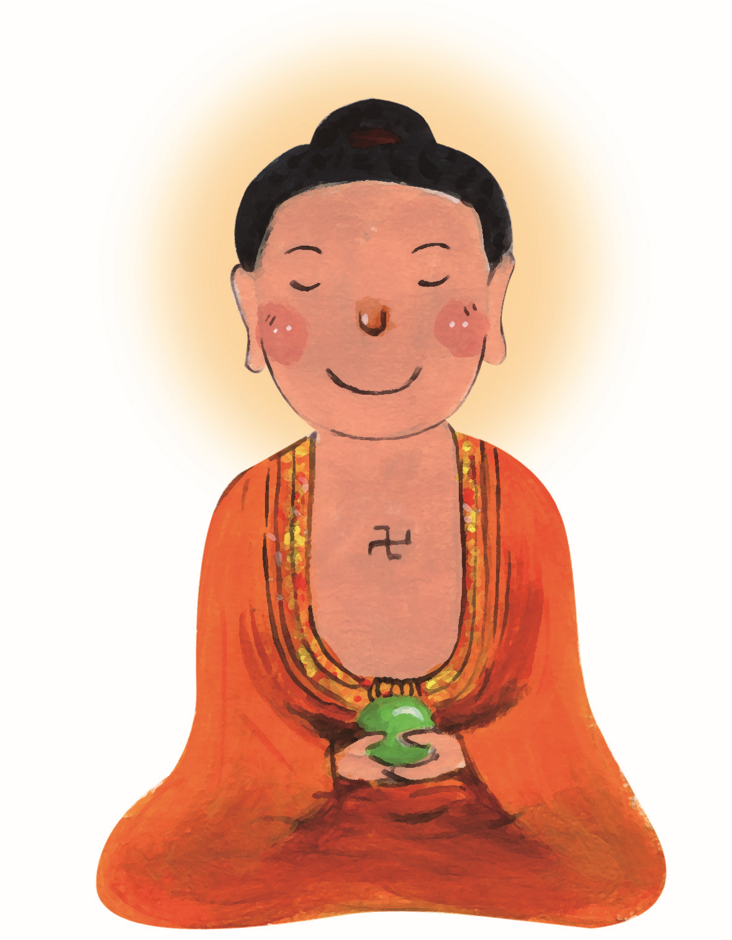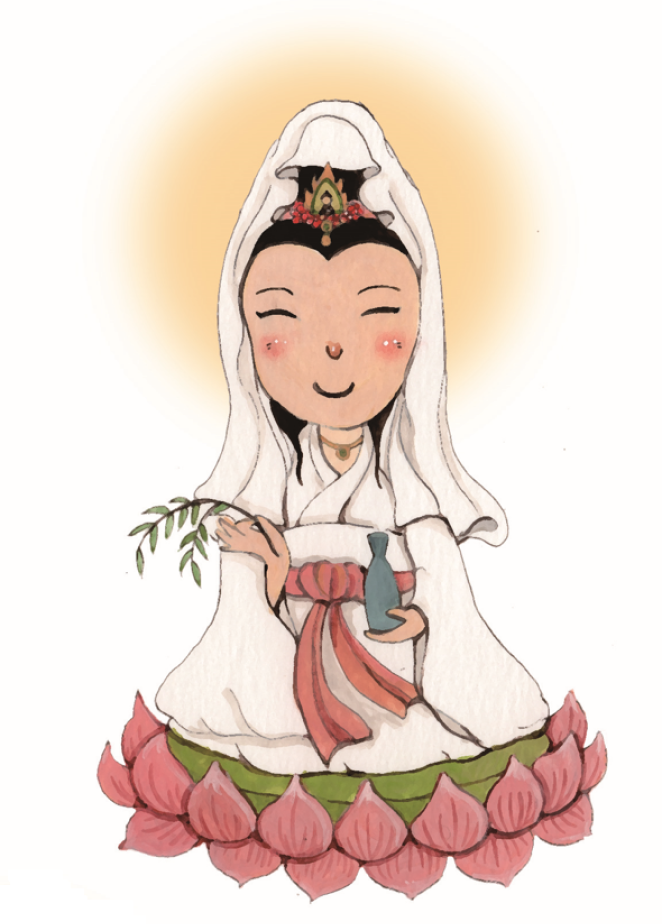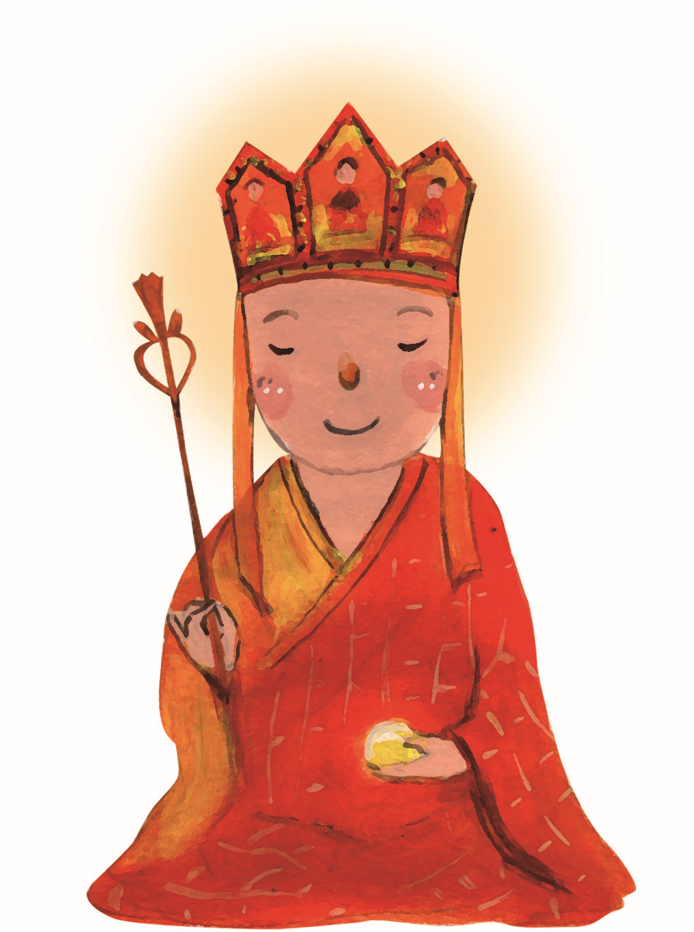Special Topics
The Triad of Sakyamuni Buddha
An introduction to combinations of Buddhist statues – one buddha flanked by two bodhisattvasThe Triad of Sakyamuni Buddha – Delivering sentient beings in the evil world of five defilements
 The three-figure arrangement typical to Buddhist statuary has emerged around the second to third century CE. This format features the central figure as the principal one, flanked by two other figures on each side. For instance, for the arrangement of three Buddha statues together, the central figure is generally Sakyamuni Buddha, along with Bhaisajyaguru on the left and Amitābha on the right. Other arrangements include one buddha accompanied by two bodhisattvas, and one buddha flanked by two disciples. The combination of Sakyamuni Buddha along with two bodhisattvas is commonly referred to as the Triad of Sakyamuni Buddha. The trio of Amitābha, Avalokiteśvara, and Mahāsthāmaprāpta are known as the Triad of Amitābha, or the Three Saints of the Western Pure Land. On the other hand, Bhaisajyaguru, along with Sūryaprabha, and Candraprabha are referred to as the Triad of Bhaisajyaguru. Based on the Ksitigarbha Bodhisattva Purvapranidhana Sutra, the combination of two Bodhisattvas, Avalokiteśvara and Ksitigarbha, flanking Sakyamuni Buddha are collectively known as the "Three Saints of the Sahā World."
The three-figure arrangement typical to Buddhist statuary has emerged around the second to third century CE. This format features the central figure as the principal one, flanked by two other figures on each side. For instance, for the arrangement of three Buddha statues together, the central figure is generally Sakyamuni Buddha, along with Bhaisajyaguru on the left and Amitābha on the right. Other arrangements include one buddha accompanied by two bodhisattvas, and one buddha flanked by two disciples. The combination of Sakyamuni Buddha along with two bodhisattvas is commonly referred to as the Triad of Sakyamuni Buddha. The trio of Amitābha, Avalokiteśvara, and Mahāsthāmaprāpta are known as the Triad of Amitābha, or the Three Saints of the Western Pure Land. On the other hand, Bhaisajyaguru, along with Sūryaprabha, and Candraprabha are referred to as the Triad of Bhaisajyaguru. Based on the Ksitigarbha Bodhisattva Purvapranidhana Sutra, the combination of two Bodhisattvas, Avalokiteśvara and Ksitigarbha, flanking Sakyamuni Buddha are collectively known as the "Three Saints of the Sahā World."The place where we mortals reside is the Sahā World, which Shakyamuni Buddha vowed to deliver in his casual ground. The Sanskrit term "sahā" implies a land of endurance or bearing. This world is named as such because the sentient beings of this world have to endure the Three Poisons–greed, aversion, and delusion–and other vexations. It is also known as the "evil world stained with the five defilements (pañca kasāyāh)," comprised of the degeneration of practice (kalpa-kaṣāya), the degeneration of views (dṛṣṭi-kaṣāya), the degeneration of afflictions (kleśa-kaṣāya), the degeneration of beings (sattva-kaṣāya), and the degeneration of life span (āyuḥ-kaṣāya). In the Sahā World–the evil world of five defilements–Shakyamuni Buddha attained the unsurpassed, complete, and perfect enlightenment (anuttara-samyak-saṃbodhi), and imparted the incredible Dharma for all sentient beings. Therefore, Shakyamuni Buddha is referred to as the teacher of the Sahā World.
In order to transform stubborn sentient beings who are difficult to train and teach, Shakyamuni Buddha went through the "Eight Great Manifestations," including the descent from the Tuṣita Heaven to the human realm, conception, birth, renunciation, conquest of demons, enlightenment, turnings of the Wheel of Dharma, and parinirvāṇa. After attaining enlightenment, the Buddha traveled in the human world to impart eighty-four thousand Dharma approaches to enlightenment, such as the Four Noble Truths and the Eight Noble Truths, the Six Perfections, and the Four All-embracing Bodhisattva Virtues.
In this Sahā world, there are two other bodhisattvas who have a special affinity with its people. According to the Kṣitigarbha Sutra, Shakyamuni Buddha instructed Kṣitigarbha to guide and teach sentient beings of the Six Destinies of Existence during the period after the Buddha's nirvana and before the descent of Maitreya into this world, until they are liberated from the cycle of saṃsāra. Kṣitigarbha thus made the great vow: "I will not attain Buddhahood before the hells are emptied; only when all sentient beings are delivered, will I attain Bodhi."
In the Kṣitigarbha Sutra, Shakyamuni Buddha also said to Avalokiteśvara, "You have a great cause and profound karmic affinity with the Sahā world." According to the Chapter on the Universal Gate in the Lotus Sutra, Avalokiteśvara travels around the Sahā world, manifesting in various forms to universally accommodate beings of different karmic capacities. Avalokiteśvara perceives sounds of beings throughout the world calling for help in order to relieve their sufferings, thereby helping and delivering all beings. These two bodhisattvas manifesting themselves in the Sahā world, together with Shakyamuni Buddha, are known as the "Three Saints of the Sahā World."
Sakyamuni Buddha

Sakyamuni Buddha is an awakened one who has attained perfection in virtue and wisdom. According to Buddhist scriptures, the Buddha has the Thirty-two Characteristics of a Great Man, and Eighty Minor Desirable Marks. The thirty -two characteristics of a great man (mahāpuruṣa lakṣaṇa) include a protuberance on the head, white fine hairs between the eyebrows, light emanating from the body, and a long and broad tongue.
Statues of Shakyamuni Buddha often come in the following postures: sitting cross-legged, sitting with legs hanging downward, standing, walking, or reclining on the right side. The five mudrās commonly held by the Buddha statues include earth-touching gesture (bhūmisparśa mudrā), turning-of-the-wheel gesture (dharmachakra pravartana mudrā), meditation gesture (dhyāna mudrā), fearlessness gesture (abhaya mudrā), and generosity gesture (varada mudrā). These mudrās represent Shakyamuni Buddha's opportune teachings that accommodate different karmic capacities of sentient beings.
Guanyin Bodhisattva (Avalokiteśvara)

According to the Chapter on the Universal Gate in the Lotus Sutra, Guanyin Bodhisattva listens to the suffering of all beings at any time, and appears in 32 kinds of physical manifestations, or response-and-transformation bodies (nirmāṇakāya), to extensively give deliverance. Guanyin Bodhisattva is deeply admired by Buddhists for the extensiveness of his Dharma approach as well as the profundity of his compassionate aspiration. Since the Tang Dynasty, the statue of Guanyin has been enshrined in almost every temple. In addition, many monasteries practice the Guanyin Dharma approach. The belief in Guanyin has spread throughout half of Asia. Sculptors even incorporated the 33 physical manifestations mentioned in Buddhist scriptures with folklore, to create the "thirty-three types of Guanyin." Among these types, the most commonly seen is the "Guanyin with a willow branch," namely, a Guanyin statue holding a vase of purifying water and a willow twig. Guanyin Bodhisattva used to be a male figure in Indian statuary, but after spreading to China, the image was gradually transformed into a female form revealing loving-kindness and solemnity. In the Ming and Qing dynasties, statues of Guanyin Bodhisattva mostly appeared in female form.
In addition, there is also the image of Guanyin Bodhisattva with "a thousand arms and a thousand eyes," with one eye in each hand, holding different Dharma instruments. This image derives from the story that, after listening to the recitation of the Nīlakaṇṭha Dhāraṇī from Thousand-light King Tathāgata of Tranquil Abode (千光王靜住如來), Guanyin Bodhisattva then aspired to have one thousand eyes to perceive sufferings of sentient beings and one thousand arms to save them. At that moment, Guanyin immediately grew a thousand arms and a thousand eyes, which moved the buddhas of the ten directions. Therefore, the thousand-armed and thousand-eyed Guanyin Bodhisattva embodies the Bodhisattva's compassion and expedient means to benefit sentient beings extensively.
Ksitigarbha Bodhisattva

The early statuary of Ksitigarbha in grottoes in Dunhuang and Longmen are in laity attire. However, since the Tang Dynasty, beliefs in Ksitigarbha began to flourish. According to the Liturgy of Ksitigarbha Bodhisattva (地藏菩薩儀軌), the Bodhisattva "takes the form of a disciple in a kāṣāya (Buddhist monastic robe) draped over his left shoulder, holding a blossoming lotus flower in his left hand, making a fearlessness gesture with his right hand, and sitting on a lotus flower." Therefore, the images of Ksitigarbha Bodhisattva are mostly of a bhikkhu wearing a kāṣāya with a khakkhara (pewter staff topped with metal rings) in hand, symbolizing his great aspiration and courageous effort to universally deliver sentient beings across heavenly worlds, the human realm, and even the hell realms.
In Japan, the belief in Ksitigarbha Bodhisattva has flourished since the Heian period. After the Kamakura period, with the merits of reciting the Ksitigarbha Sutra stated in the scripture, the Bodhisattva was transformed into Koyasu Jizō (子安地蔵) and Enmei Jizō (延命地蔵), blessing people with easy delivery in childbirth and smooth child development without premature death. The statue of Ksitigarbha Bodhisattva in Japan may also appear in the monastic form. However, it has a face of a child and is often surrounded by children. This image highlights the function of the Ksitigarbha method in benefitting people by enhancing longevity.
Related articles:
Buddhas and Bodhisattvas in the Pure Lands
The Triad of Sakyamuni Buddha
Three Saints of the Ghanavyūha
Three Saints of the Western Pure Land
Three Saints of the Eastern Pure Land
Buddhas of the Three Times
One Buddha Flanked by Two Disciples
Resource: Issue 402 of Humanity Magazine, Dharma Drum Publishing Corporation
Translation: Sinag-ling Li (李祥苓)
Editing: Keith Brown, Chia-Cheng Chang (張家誠)
